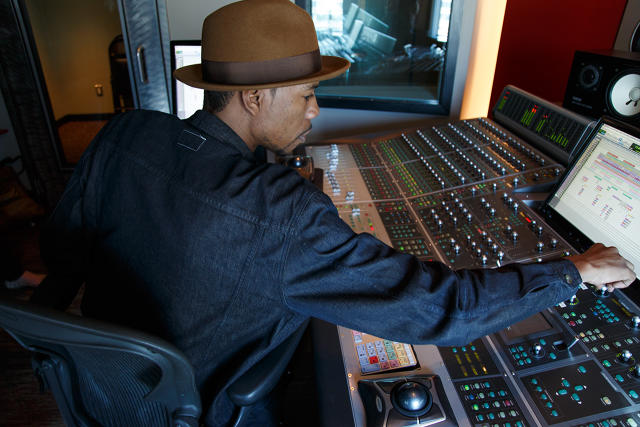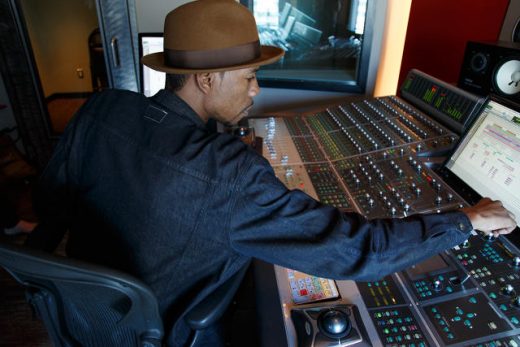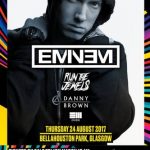Need To Remix Your Creativity? Hip-Hop’s Go-To Music Engineer Has Some Sound Advice
Gimel “Young Guru” Keaton, one of the music industry’s best-known audio engineers, has helped craft tracks that have been recorded by the likes of Beyoncé, Drake, Rihanna, and Jay Z, whose hits he’s most closely associated with. As an expert in the recording studio’s technical intricacies who’s also deeply steeped in hip-hop culture (he has a side gig as director of operations for indie rap label Jamla Records), Guru has worked closely with producers such as Pharrell Williams and Just Blaze to help bring their sonic ideas to life. “We’re problem solvers,” he says of his role in the recording process. “Anytime there’s a problem, an engineer is supposed to perk up and be like, ‘Oh, wow, this is a challenge for me. I have something to design and build to figure this out.'” After spending more than 20 years and countless hours behind the soundboard, here are some of the ways that Young Guru has found to keep himself inspired and continue doing his highest-caliber work.
Team up with the best
Young Guru and Jay Z met in 1999 after the engineer was hired for an album by Jay Z’s protégé Memphis Bleek, who was signed to the rapper’s Roc-A-Fella Records. They’ve collaborated closely ever since, and Guru has helped create huge tracks such as “Empire State of Mind,” “Izzo (H.O.V.A.),” and “Dirt Off Your Shoulder.” “I’m lucky in that Jay completely gets the whole process,” says Guru. “He comes in, tells you what he wants, and lets you work. He either likes it or doesn’t, or he’ll give notes. My job is to translate his layman’s terms into audio terms.”
But also make time for up-and-comers
When you’re at the top of your profession, it’s easy to fall into routines. Working with young, unestablished artists can push you in unexpected directions. “With Jay [Z], it’s like, how do we continue to grow and not fuck up the legacy? But it’s very hard to sit in a room after that many albums and be like, ‘What haven’t we talked about?'” Guru is always looking for the next sound, a new source of inspiration. “I tell Jay sometimes, ‘You’re so up in the clouds that sometimes you miss ground-level shit or you can’t start messing with it until it gets to a certain level because of who you are and your reputation.”
Remember: It’s not about you
An engineer’s job is to make the artist and producer sound their best. Though Guru is now relatively well known, he’s careful to keep in mind that he is not the star. “When you go to a live show, you’re not sitting there like, ‘Yo, the engineer is killing it! What preamps did he use?’ The only time you think about [an engineer] is when it sounds horrible. Our job is to be out of the way and make the artist shine.”
Protect your creative space
With today’s studio technology, artists and even producers aren’t necessarily in the studio while Young Guru is working on tracks. In some ways, that can be helpful. “I don’t like someone over my shoulder,” he says. “It’s like you’re cooking and someone’s constantly sticking their finger in. When they’re like, ‘This tastes nasty,’ it’s like, ‘No shit, I just started. There’s no sugar in it yet! Let me finish cooking.'” But there are downsides, too. In the old days, everyone would sit together in a room until a track was complete. “It was me, the producer, and the artist, and at the end of the day all of us were there; we made a decision. We went, ‘Yo, the record is done. It sounds good. Print that.’ [Now] I rarely mix a record with an artist in the room. I’m in here by myself. I get my mix where I think it’s comfortable, and I email it to them. A little five-second [tweak] now can turn into days, because if they’re on the road or whatever, they may not listen to it right that second. I’m in here sitting, and they may go, ‘I’ll get to it tomorrow.'”

Throw some McDonald’s in it
Great artists don’t always find wide audiences; if your goal is to reach a lot of people, sometimes you have to tailor your approach. “I’m the super-underground hip-hop guy—I want to hear intricate shit,” says Guru. “Jay’s like, ‘Gu, I can rhyme for you all day—that’s not going to sell albums. I have to make this interesting enough for the people who don’t care about that as well as for you.’ That’s our challenge—it’s a balance. The audience doesn’t buy pure art, so I got to throw some McDonald’s in it. There’s a reason McDonald’s sells billions.”
A version of this article appeared in the May 2016 issue of Fast Company magazine.
(47)














